(Clearwisdom.net)
Part One: Introduction
Inspired by the results of the health survey conducted in China before July 1999, [when the Jiang's regime started to persecute Falun Gong], several Falun Dafa practitioners in North America have conducted a small-scale health survey on the cultivation of Falun Gong.
Owing to the more complex nature of the make up of the people in North America and that most of the practitioners in North America have a high educational background, we therefore added the item of level of education in our questionnaire. Because Falun Dafa has made it possible for many practitioners to quit smoking we added the item of smoking before and after practicing Falun Gong to estimate the number of people who gave up smoking. As for the general improvement of health conditions we made use of some of the questions the US National Health Bureau used in its "National Health Survey" of people of the middle-aged group.
We sent the questionnaires to a group of practitioners in the United States and Canada, who were willing to take part in it and we collected 235 responses, of which 202 were from the United States, 32 were from Canada and one from another country. The comparison of the collected data on health conditions before and after practicing Falun Gong shows that practicing Falun Gong has helped in their health improvement. The data collected were keyed into EXCEL and the actual analysis and calculation were carried out by statistics software SAS and S-PLUS.
The statistics showed that the practitioners in North America are relatively young and have very good educational background. The self-evaluation on their health conditions before and after practicing Falun Gong showed that their health conditions have greatly improved. Following are the results.
Part Two: Survey Results
A. Geographic Distribution
A.1. State/Province
(Table 1) Geological Distribution of the People Surveyed

Twenty-one of the people surveyed did not specify their state/province. The above table shows the number of survey results collected from various states/provinces.
A.2. Gender 137 (58.3% Female and 98 (41 %) male
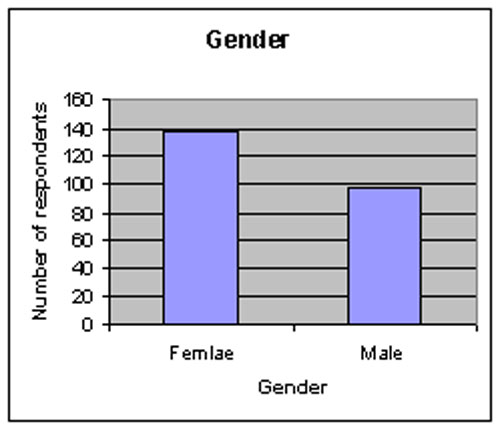
Fig 1 The Distribution of Gender
A.3. Race Among the 233 responses 226 (97 %) are Chinese and 7 (3 %) Caucasian.
A.4. Age Among 230 responses the average age is 38.9 (The standard deviation is 13.6 and the age ranges from 4 to 78.)
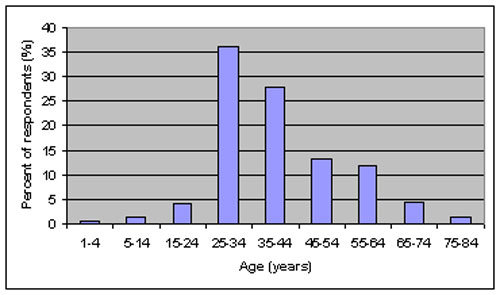
Fig 2 the Distribution of Age
A.5. Length of Practice (Up to December 1999) Among the 229 responses, the average length of practice is 26.4 months (The standard deviation is 14.2 and the range of duration is 1 to 64 month.)

Fig 3 The Distribution of the Length of Practice
A.6. Education Level Among the 233 responses, we have only taken into consideration the highest degree of education obtained by the age group of 18 years and above. (Fig 4)
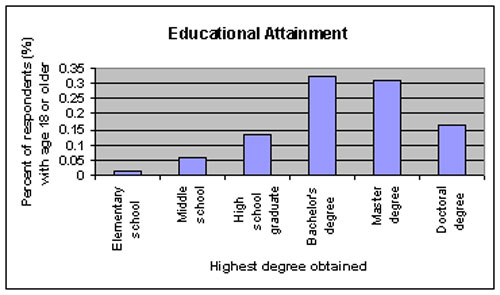
Fig 4 The Distribution of Educational Attainment
A.7. Occupation Fig 5 shows the distribution of business/industry employed of the people (137 people).
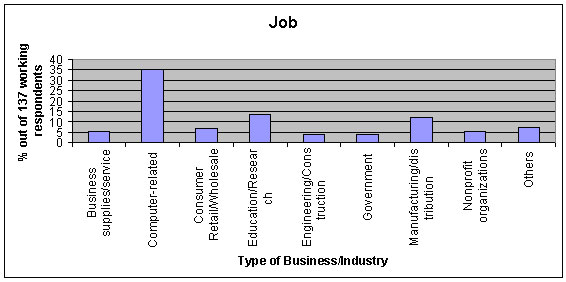
Fig 5 Employment Distribution
B. Health Data
B1. Height and weight Of the age group18 and above (230 people, the average height for males is 172cm (The standard deviation is 8.2cm; the average height for females is 159.2cm (The standard deviation is 5.5cm. The average weight for males is 67.9 kilo (The standard deviation is 11.4 kilo; the average weight for females is 56.6 kilo. The standard deviation is 10.9 kilo).
B.2. Status of Smoking and Drinking 18 cases had a habit of smoking before practice and all of them quit smoking after practice. It only took an average of 4.58 days for them to quit smoking. 103 cases had a habit of drinking before practice, 100 cases quit drinking after practice, 2 cases drink less than 3 cups a week, and 1 case did not fill out the answer.
B.3. Self Evaluation of Health Conditions Before and After Practice Participants
The responses handed in by 230 participants contain complete information about their health conditions before practice.

Fig 6 Statistics on Health Conditions Before Practice
The responses that 226 participants handed in contain complete information about their health conditions after practice.

Fig 7 Statistics on Health Conditions After Practice
From the results of Fig 6 and Fig 7 as well as table 2 we can see that 224 participants had markedly improved their health conditions after practice.
Table 2 Comparison of Health Conditions Before and
After Practice

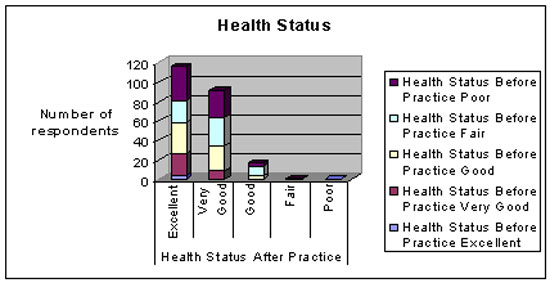
Fig 8 Comparison of Health Status Before and After Practice
B.4. Status About Illnesses Before and After Practice.
Table 3 Statistics on Improvement of Diseases After Practice
|
Total Number of Disease Cases |
||||||
|
Type of Disease |
Total Recovery |
Marked Improvement |
Improved |
No Change |
Getting Worse |
Total |
|
High Blood Pressure |
7 |
5 |
1 |
1 |
0 |
14 |
|
Heart Disease |
14 |
5 |
0 |
0 |
0 |
19 |
|
Stroke |
1 |
2 |
0 |
0 |
0 |
3 |
|
Emphysema or Asthma Alimentary Canal Ulcer Cancer |
10 35 4 |
2 9 2 |
0 1 0 |
0 0 0 |
0 0 0 |
12 45 6 |
|
Diabetes & High cholesterol |
2 |
2 |
1 |
0 |
0 |
5 |
|
Pollenosis Sinusitis |
23 13 |
2 2 |
0 1 |
0 0 |
0 0 |
25 16 |
|
Chronic Bronchitis Kidney Failure |
8 13 |
2 3 |
0 1 |
0 0 |
0 0 |
10 17 |
|
Hepatitis & Other Liver Related Diseases |
11 |
3 |
0 |
0 |
0 |
14 |
|
Other Diseases |
40 |
18 |
2 |
1 |
0 |
61 |
B.5.
Status of uncomfortable symptoms before and after practice. Table 4 sums up the improvement of those uncomfortable symptoms before and after practice. These symptoms had not been diagnosed by doctors. From the table we can see that the symptoms have shown distinct improvement.Table 4 Statistics on the Improvement of Uncomfortable Symptoms
|
Total Number of Cases |
||||||
|
Symptoms of Upset |
Total Recovery |
Marked Improvement |
Improved |
No Change |
Getting Worse |
Total |
|
Joints and the Surrounding Areas Discomfort Such As Pain, Stiffness & Swelling |
43 |
12 |
2 |
1 |
0 |
48 |
|
Pain Such As Backache, Muscle Ache, Headaches and Migraine Headaches |
74 |
14 |
4 |
7 |
0 |
99 |
|
Insomnia, Hearing Impairments |
2 |
0 |
0 |
1 |
0 |
3 |
|
Chronic Fatigue |
40 |
8 |
3 |
0 |
0 |
51 |
|
Other Symptoms Not Diagnosed by Doctors |
40 |
18 |
2 |
1 |
0 |
61 |
Part Three: Conclusion
This report on the health survey is a summary of the results of a survey of 235 Falun Gong practitioners on their health status. It shows that practicing Falun Dafa is beneficial to health. After practicing, the chronic diseases suffered by some of the practitioners completely disappeared, some had their symptoms reduced and smokers have quit smoking. By using a statistics model (not shown here) to handle these data it showed that the result of most of the participants indicates that the longer they practice the better improvement of their health.





